
![]()
Search the Journey to Forever website – click HERE
|
Journey to Forever: Make a donation |
Navigation
Contact usTo Keith Addison Handmade Projects |
School composting
Gardening and composting go hand-in-hand, especially in school garden projects: gardening without composting only teaches half the lesson.
Composting concerns the invisible half of the Wheel of Life, Nature's cycle of growth and decay. This is the vital part that happens underground, where wastes decay to give rise to new life. Composting helps to bring the regenerative capabilities of the soil to a high peak of natural efficiency, ensuring a bountiful, beautiful and healthy garden.
Learning about soil
Soil is made of air, water, minerals, and organic matter. The mineral portion is usually about half the total volume, water and air up to a quarter each, and organic matter about 5% or more. The mineral particles come in three sizes: biggest is sand, then silt, and clay is the smallest.
Sand is mostly quartz. Sandy soil drains well and doesn't get so muddy or sticky when it's wet, but it usually isn't very fertile because sand contains no plant nutrients. Silt is also quartz, but the particles are much smaller than sand.
Clay particles are tiny, and much more complex than sand or silt. Clay particles are tiny lattices made up of plates and can hold large amounts of plant nutrients. Clay soil can be heavy and sticky, with bad drainage, but it depends on the overall soil condition: well-maintained and composted clay soil is very fertile and not difficult to work.
Most soils are "loams", a mixture of sand, silt and clay. Soil textures range from: sand, loamy sand, sandy loam, fine sandy loam, loam, silty loam, silt, silty clay loam, clay loam, clay.
More important is the organic matter content of the soil, composed of decaying and decayed plant matter (humus) and living creatures. This is where the billions of soil microorganisms live and do their work, and if they're happy, it's a good soil, regardless of how much clay or sand it has.
An acre of good, living soil can contain 900 pounds of earthworms, 2,400 pounds of fungi, 1,500 pounds of bacteria, 133 pounds of protozoa, 890 pounds of arthropods and algae. They're sometimes called the "micro-herd" -- the most important livestock on the farm.
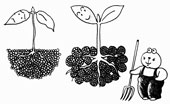 Compost improves the soil structure ("Soil and compost" by Toshihide Matsuzaki) |
To check soil composition:
- Take a clean, clear-glass jam jar with a tight-fitting lid.
- Spoon some soil into it -- about one-third full.
- Add clean water up to three-quarters full.
- Screw on the lid and shake the jar vigorously, thoroughly mixing soil and water.
- Let it stand for a day or so.
The largest mineral particles -- sand -- sink to the bottom first, forming a distinct layer, followed by the silt, and finally the clay, giving a clear picture of the soil type. Most of the organic matter floats to the surface.
See Composting pages for more detail and more resources.
Composting resources for schools
These resources cover both composting and vermicomposting (composting with red worms) -- kids love worms! There are resources for both indoors and outside.
For vermicomposting, schools that do not operate year-round will need to arrange to feed the worms during the holidays. Apply a layer of compost or well-rotted horse manure every two weeks. Check the moisture level.
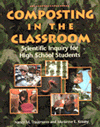 "Composting in the Classroom: Scientific Inquiry for High School Students" by Nancy Trautmann and Marianne Krasny, Kendall/Hunt, 1997, ISBN 0-7872-4433-3
"Composting in the Classroom: Scientific Inquiry for High School Students" by Nancy Trautmann and Marianne Krasny, Kendall/Hunt, 1997, ISBN 0-7872-4433-3
A comprehensive guide for teachers on composting research projects for high school students. Biology, chemistry, and physics of composting, instructions for building indoor and outdoor compost bins, both thermophilic or "hot" composting and worm composting, guidelines for studying the effects of compost on plant growth, and more. Recommended by the US National Science Teachers Association: "This book provides an excellent model of applied content following the recommendations of the National Science Education Standards. Composting in the Classroom is a powerful addition to the science teacher's bookshelf." Free download (2.4Mb pdf):
http://cwmi.css.cornell.edu/compostingintheclassroom.pdf
See Table of Contents:
http://compost.css.cornell.edu/CIC.html
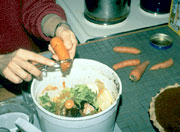 The Composting in Schools section at Cornell University has useful outlines for schools composting projects online (adapted from the book "Composting in the Classroom"), including lesson plans, integration with other subjects. "Why composting?" outlines good reasons for composting in general and for composting in the classroom in particular. Teacher's page, ideas for student research projects, compost quiz, science and engineering, composting indoors, composting outdoors, weird and unusual composting, frequently asked questions, glossary, feedback.
The Composting in Schools section at Cornell University has useful outlines for schools composting projects online (adapted from the book "Composting in the Classroom"), including lesson plans, integration with other subjects. "Why composting?" outlines good reasons for composting in general and for composting in the classroom in particular. Teacher's page, ideas for student research projects, compost quiz, science and engineering, composting indoors, composting outdoors, weird and unusual composting, frequently asked questions, glossary, feedback.
http://compost.css.cornell.edu/schools.html
See also Small Scale Composting, School Composting -- FAQs, ideas, bioreactors, projects, troubleshooting, resources:
http://cwmi.css.cornell.edu/composting.htm#other

Building a Soda Bottle Bioreactor -- Composting in Schools, Cornell University's Center for the Environment: "Soda bottle bioreactors are designed to be used as tools for composting research. They are small and inexpensive enough to enable students to design and carry out individualized research projects, comparing variables such as reactor design, moisture content, and nutrient ratios of mixtures to be composted." Details online:
http://www.css.cornell.edu/compost/soda.html
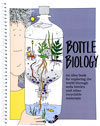 Bottle Biology : An Idea Book for Exploring the World Through Plastic Bottles and Other Recyclable Materials, by Mill Ingram, Kendall/Hunt, 1993, 128 pages, ISBN 084038601X -- Build a compost column, create a spider habitat, observe the life cycle of a slime mould. Filled with innovative ideas for learning about science and the environment. Buy at Amazon.com: Bottle Biology: An Idea Book
Bottle Biology : An Idea Book for Exploring the World Through Plastic Bottles and Other Recyclable Materials, by Mill Ingram, Kendall/Hunt, 1993, 128 pages, ISBN 084038601X -- Build a compost column, create a spider habitat, observe the life cycle of a slime mould. Filled with innovative ideas for learning about science and the environment. Buy at Amazon.com: Bottle Biology: An Idea Book
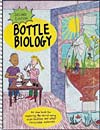 Bottle Biology, by Wisconsin Fast Plants Program, 2nd edition, 2008, Kendall/Hunt, 136 pages, ISBN 0757500943 -- sections on soil, worms, composting, and more, some projects for elementary students, most for older students. Buy at Amazon.com: Bottle Biology
Bottle Biology, by Wisconsin Fast Plants Program, 2nd edition, 2008, Kendall/Hunt, 136 pages, ISBN 0757500943 -- sections on soil, worms, composting, and more, some projects for elementary students, most for older students. Buy at Amazon.com: Bottle Biology
Worm Bin Project -- Michigan State University College of Education and Ameritech, Middle Elementary grade. Students learn about decomposition and the life cycle via small wooden worm bins, only 5 inches square. Collect and share scientific data with students in another school via email, with directed Internet and library searches. Lesson plans online, five lessons over two months: Introduction to Worm Bin Project, Collaboration Online, Growing Plants with Worm Castings, Decomposition, Soil, and Life Cycle Research, and Presentation of Findings.
http://commtechlab.msu.edu/sites/letsnet/
noframes/subjects/science/b2u1.html
The Adventures of Squirmin' Herman the Worm -- On-line interactive plant science curriculum for grades 4 and 5, from Chicago Urban Gardening, University of Illinois. Teaches students the basic vocabulary of biology: biological composition, digestion and reproduction told through a guided study of the worm; principles of basic scientific research and application through the creation, observation and maintenance of a worm bin -- biological and physical sciences, fine arts, language arts, math, social sciences. My History, My Family Tree, My Anatomy, Come Live With Me, Worm Deli, Can't Live Without Me, Worm Facts, My Fun Place, Worm Links. And a Certified Wormologist certificate. Like its sister site at the Great Plant Escape, a clever, well-implemented learning site.
http://www.urbanext.uiuc.edu/worms/
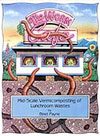 "The Worm Cafe -- Mid-Scale Vermicomposting of Lunchroom Waste" by Binet Payne, 1999, Flower Press, ISBN 0-942256-11-5, 200 pages -- How an enthusiastic teacher and her students developed a system to compost lunchroom waste with red worms, saving their school US$6,000 a year in reduced waste disposal fees. Well illustrated with a wealth of useful information, useful guide for teachers interested in starting a classroom or school-wide vermicomposting program. Work sheets, a letter to parents, posters, quizzes, and a 30-page annotated guide to useful curricular materials on animals, plants, nature, and values divided into sections for children and for adults. Binet Payne based her system on "Worm Woman" Mary Appelhof's popular how-to book, Worms Eat My Garbage (below). Buy at Amazon.com: The Worm Cafe
"The Worm Cafe -- Mid-Scale Vermicomposting of Lunchroom Waste" by Binet Payne, 1999, Flower Press, ISBN 0-942256-11-5, 200 pages -- How an enthusiastic teacher and her students developed a system to compost lunchroom waste with red worms, saving their school US$6,000 a year in reduced waste disposal fees. Well illustrated with a wealth of useful information, useful guide for teachers interested in starting a classroom or school-wide vermicomposting program. Work sheets, a letter to parents, posters, quizzes, and a 30-page annotated guide to useful curricular materials on animals, plants, nature, and values divided into sections for children and for adults. Binet Payne based her system on "Worm Woman" Mary Appelhof's popular how-to book, Worms Eat My Garbage (below). Buy at Amazon.com: The Worm Cafe
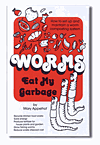 "Worms Eat My Garbage: How to Set Up and Maintain a Worm Composting System" by Mary Appelhof, Flower Press, Kalamazoo, Michigan, 1982 -- A quick, easy read, simple and positive guide to vermicomposting by biologist Mary Appelhof, aka "Worm Woman", who fed her garbage to worms for more than 25 years. The most popular worms book -- more than 165,000 copies sold. Buy at Amazon.com: Worms Eat My Garbage
"Worms Eat My Garbage: How to Set Up and Maintain a Worm Composting System" by Mary Appelhof, Flower Press, Kalamazoo, Michigan, 1982 -- A quick, easy read, simple and positive guide to vermicomposting by biologist Mary Appelhof, aka "Worm Woman", who fed her garbage to worms for more than 25 years. The most popular worms book -- more than 165,000 copies sold. Buy at Amazon.com: Worms Eat My Garbage
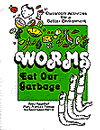 "Worms Eat Our Garbage: Classroom Activities for a Better Environment" by Mary Applehof, Mary Frances Fenton & Barbara Loss Harris, 1993, Flowerfield, ISBN-10: 097780450X, 232 pages -- Worm expert Mary Appelhof's book for schools. Full curriculum for home, school and outdoor centres deals with the subject of earthworms, integrates science, maths, language arts, biology, solid waste issues, ecology and the environment. More than 150 worm-related activities (one per page) to develop problem-solving and critical-thinking skills. 232 pages. For grades 4-8. Non-copyright -- pages can be copied and used in class. A great resource book. Buy at Amazon.com: Worms Eat Our Garbage
"Worms Eat Our Garbage: Classroom Activities for a Better Environment" by Mary Applehof, Mary Frances Fenton & Barbara Loss Harris, 1993, Flowerfield, ISBN-10: 097780450X, 232 pages -- Worm expert Mary Appelhof's book for schools. Full curriculum for home, school and outdoor centres deals with the subject of earthworms, integrates science, maths, language arts, biology, solid waste issues, ecology and the environment. More than 150 worm-related activities (one per page) to develop problem-solving and critical-thinking skills. 232 pages. For grades 4-8. Non-copyright -- pages can be copied and used in class. A great resource book. Buy at Amazon.com: Worms Eat Our Garbage
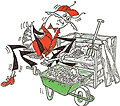 Making a compost heap, Garden Organic for Schools, by Garden Organic, Britain's Organic Association (the HDRA) -- learning zone:
Making a compost heap, Garden Organic for Schools, by Garden Organic, Britain's Organic Association (the HDRA) -- learning zone:
http://www.gardenorganic.org.uk/
schools_organic_network/lz_comp.htm
Teaching zone:
http://www.gardenorganic.org.uk/
schools_organic_network/tz_comp.htm
Vermicomposting Classroom Activities, California Integrated Waste Management Board -- 34-page course covers the subject from start to finish (growing plants in compost) in an organised way, learning made easy. 396 kb pdf:
http://www.ciwmb.ca.gov/Schools/Curriculum/Worms/98Activities.pdf
The Worm Guide: A Vermicomposting Guide for Teachers, California Integrated Waste Management Board, 2004, 48 pages -- Vermicomposting basics, Tgheb Garden Connection, Closing the food loop at your school, and more. 1.4 Mb pdf:
http://www.ciwmb.ca.gov/Publications/Schools/56001007.pdf
Full Educational Unit at the Reln Teachers Page for use by schools, or by parents at home, to educate children on composting and the benefits of minimizing waste, while integrating the various activities into many different classroom subjects. Lesson ideas and suggestions for primary school children. Reln makes the Can-O-Worms and Worm Factory vermicomposting bins, useful but not essential for using these online resources.
http://www.reln.com.au/educational_unit.php
See: School gardening
Trees and forests -- resources for schools
See also:
Organic gardening
Composting
City farms
Small farms
Trees, soil and water
Seeds of the world